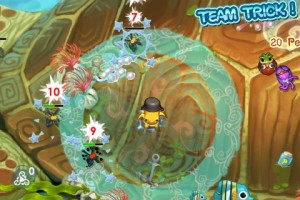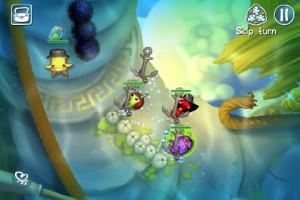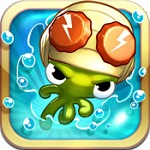When you spend most of your life scouring the ocean floor for pearls, the most dangerous threats come from the one direction you don’t look in so often: up. A mysterious sludge has begun raining down on the world of the Squids (Out Now, $0.99), turning all benthic life it touches into mindless marauders. With most of the old guard going down or already fallen, a squad of unlikely heroes sets out to gather the last of their kind who can handle a good, old fashioned fish fight.
 Squids may spin a yarn that sounds trite enough on paper – how many times have we played RPGs where a deadly fog was the culprit? – but its narrative quality clearly stands out on iOS. Its structure is mission-based as gamers have become so used to on this platform, each level treating the player to a narrative snippet of the dialogue-and-portrait variety. Backed up by gorgeous art stills, the story segments present a cast of well-delineated personalities that draw the player into Squids’ world; when an RPG fan as jaded as I am starts feeling attached to anthropomorphic mollusks, that’s saying a lot. There’s precious little time built into the plot for exploring the deeper mysteries of Squids’ world, but the setup is solid and a few characters hide fun secrets that are gradually teased out over the long haul.
Squids may spin a yarn that sounds trite enough on paper – how many times have we played RPGs where a deadly fog was the culprit? – but its narrative quality clearly stands out on iOS. Its structure is mission-based as gamers have become so used to on this platform, each level treating the player to a narrative snippet of the dialogue-and-portrait variety. Backed up by gorgeous art stills, the story segments present a cast of well-delineated personalities that draw the player into Squids’ world; when an RPG fan as jaded as I am starts feeling attached to anthropomorphic mollusks, that’s saying a lot. There’s precious little time built into the plot for exploring the deeper mysteries of Squids’ world, but the setup is solid and a few characters hide fun secrets that are gradually teased out over the long haul.
With Action RPGs starring lone heroes being the norm on iOS, I was relieved to finally get my tentacles on a great combat system of the turn-based variety, with the player directing up to four characters at once. Squids strikes a miraculous balance: its interface is simple and casual-friendly but its gameplay is filled with enough nuance to satisfy RPG and Turn-Based Strategy veterans. A squid warrior’s turn can play out any number of ways depending on how its stamina gauge is allocated. The player can spend some points flinging it toward treasure chests, torpedoing it at several enemies in succession, or carefully lining up one enemy for the final shot needed to push it over a ledge and into oblivion, just like a billiard ball. The squids at the player’s command fall into different character classes, each with a special ability separate from the stamina system. Therefore the player may lengthen a Scout’s turn with a dash attack or two after a fling; a heavy Trooper can devastate an enemy crowd with a stomp attack once it’s in position.
The character system could still go much further by incorporating things like class changes and skill trees, but lack thereof is offset by the strong role environment design plays. By the time the player reaches the halfway mark of Squids’ campaign, knocking enemies off ledges becomes the most efficient way to victory — and letting the same fate befall one’s own squids the surest path to defeat. Environments absolutely explode into sprawling, intricate physics puzzles where the player has to maneuver cautiously and search for opportunities the developers have carefully planted. Flinging a squid toward anchors can help it swim against currents; sea urchins, normally stationary threats, can become potent weapons if shot into enemy crowds with help from neutral rocks that can act as cue balls. Various jars strewn over the field hold one-time use items that can shield a squid from attack, refill its stamina gauge for more actions in the current turn, or heal it. The player’s attention is firmly fixed on the evolving battlefields rather than the unchanging nature of each character’s abilities.
 Squids’ hard focus on battle cuts out the town wandering and shopping runs that turn-based RPG fans typically associate with the genre; all character and inventory management occurs between missions. Level Ups are made at the player’s discretion in exchange for pearls collected from treasure chests and defeated enemies. An even better way to upgrade stats is to find hats that serve as equipment; in a bit of a weird twist, the stats associated with hats can be permanently absorbed by the squids. After that, they’re used solely to customize character appearance. Items that revive fallen squids or summon giant sea monsters during battle are also available in the upgrade system, but take care during shopping sprees. Some consumables cost pearls, some are In-App Purchases, and they’re intermingled in the shop menu.
Squids’ hard focus on battle cuts out the town wandering and shopping runs that turn-based RPG fans typically associate with the genre; all character and inventory management occurs between missions. Level Ups are made at the player’s discretion in exchange for pearls collected from treasure chests and defeated enemies. An even better way to upgrade stats is to find hats that serve as equipment; in a bit of a weird twist, the stats associated with hats can be permanently absorbed by the squids. After that, they’re used solely to customize character appearance. Items that revive fallen squids or summon giant sea monsters during battle are also available in the upgrade system, but take care during shopping sprees. Some consumables cost pearls, some are In-App Purchases, and they’re intermingled in the shop menu.
Squids’ pull-back and tap mechanics for executing attacks all feel intuitive, and the player sifts through very few menus as far as RPGs go. I found the fling accuracy requirement pretty forgiving, so consider this one perfectly approachable even if you aren’t a master of titles like Angry Birds or Bouncy Mouse. Its campaign contains 21 levels at release, with each getting progressively longer; if the game has a weakness, it’s that it’s meant for lengthy sit-down-and-play sessions rather than quick spurts. All told, Squids should last upwards of eight hours on average.
From the lush hand-drawn environments to the full-body character portraits, the amount of aesthetic polish The Game Bakers lathered onto Squids is nothing short of incredible. The character artist’s work is every bit as critical to holding the game’s plot together as anything the heroes say; it was Winnick’s pouting glare at the falling ooze that first pulled me in, and Clint’s shifty eyes when being asked about his past that strung me along for the rest of the ride. Equally deserving of commendation are the orchestral soundtrack and especially the audio engineering — all the little yelps the squids make as they’re being bounced around are priceless.
iFanzine Verdict: An RPG this perfect is rarely seen on the App Store. Squids enjoys a delightful presentation, intuitive and creative game mechanics seldom used in the genre, and way more content than the price range would suggest. If that $0.99 price tag isn’t a release sale, please pinch us, because we must be dreaming.


